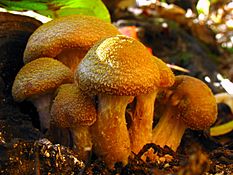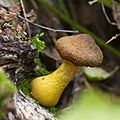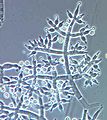Armillaria gallica facts for kids
Quick facts for kids Armillaria gallica |
|
|---|---|
 |
|
| Scientific classification | |
| Kingdom: | |
| Division: | |
| Class: | |
| Order: |
Agaricales
|
| Family: |
Physalacriaceae
|
| Genus: |
Armillaria
|
| Species: |
A. gallica
|
| Binomial name | |
| Armillaria gallica Marxm. & Romagn.
|
|
Armillaria gallica is a type of "honey mushroom." It is also known by other names like A. bulbosa and A. lutea. This fungus is very common and important for nature. It helps to break down wood.
Armillaria gallica can live in two ways. It can be a saprophyte, which means it feeds on dead wood and plants. It can also be a parasite on weak trees, causing their roots or lower trunk to rot. You can find this fungus in cool, mild areas of Asia, North America, and Europe. It has also accidentally spread to South Africa.
The fungus grows its visible parts, called fruit bodies, alone or in groups on soil or rotting wood. These fruit bodies can be up to 10 cm (4 inches) wide. They are yellow-brown and covered with small scales. Underneath the cap, there are gills that are white, creamy, or pale orange.
This fungus has a huge network of underground root-like structures called rhizomorphs. These help it break down dead wood in forests with many different kinds of trees. Scientists have studied Armillaria gallica a lot. They are especially interested in its ability to glow in the dark and how it forms very large and long-lasting groups, called colonies.
Discovering the Humongous Fungus
In the early 1990s, scientists found a huge Armillaria gallica in Michigan, USA. They were studying a forest where oak trees had been cut down, and their stumps were left to rot. Later, when new pine trees were planted there, the fungus killed the young trees.
Scientists used special tests to study the fungus's genetic material. They found that the underground network of one single fungus covered 15 hectares (about 37 acres). This one fungus weighed over 9,500 kg (21,000 pounds)! Scientists estimated it was about 1,500 years old.
They collected samples from the fruit bodies and rhizomorphs across the 15-hectare area. All the samples had the exact same genetic information. This proved that they were all part of one giant living thing, like a clone. It grew to this huge size by simply spreading its parts.
The scientists said that fungi should be seen as some of the oldest and largest living things on Earth, just like giant redwood trees or blue whales. After this discovery was shared, news reporters from all over the world visited the site. Because of all the attention, this particular fungus became famous and was nicknamed the "humongous fungus." There was some discussion among experts about whether it truly compared to other very large organisms.
Gallery
Images for kids
See also
 In Spanish: Armillaria gallica para niños
In Spanish: Armillaria gallica para niños











